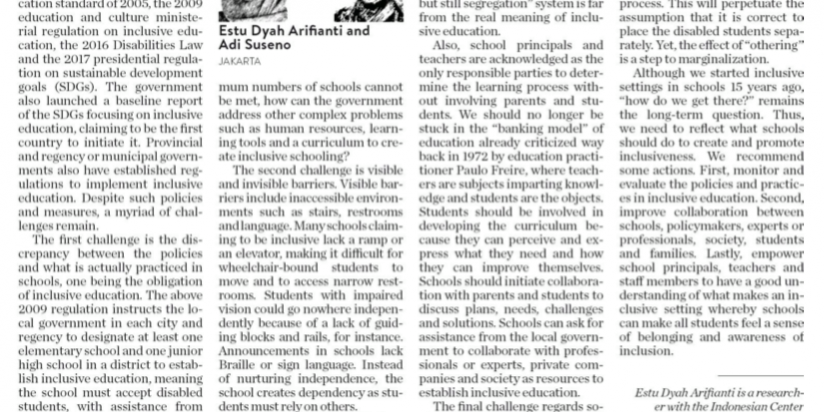It has been 15 years since inclusive education came to the fore in 2003. Related policies include the 2003 Education Law, the national education standard of 2005, the 2009 education and culture ministerial regulation on inclusive education, the 2016 Disabilities Law and the 2017 presidential regulation on sustainable development goals (SDGs). The government also launched a baseline report of the SDGs focusing on inclusive education, claiming to be the first country to initiate it. Provincial and regency or municipal governments also have established regulations to implement inclusive education. Despite such policies and measures, a myriad of challenges remain.
The first challenge is the discrepancy between the policies and what is actually practiced in schools, one being the obligation of inclusive education. The above 2009 regulation instructs the local government in each city and regency to designate at least one elementary school and one junior high school in a district to establish inclusive education, meaning the school must accept disabled students, with assistance from the local government if needed. However, Statistics Indonesia records 7,024 districts in 2014 while in 2016 inclusive junior high schools officially numbered 3,817, almost half of the minimum commitment. The ministry in 2017 also stated that only 18 percent of disabled students were studying in inclusive schools. If the commitment to build a minimum numbers of schools cannot be met, how can the government address other complex problems such as human resources, learning tools and a curriculum to create inclusive schooling?
The second challenge is visible and invisible barriers. Visible barriers include inaccessible environments such as stairs, restrooms and language. Many schools claiming to be inclusive lack a ramp or an elevator, making it difficult for wheelchair-bound students to move and to access narrow restrooms. Students with impaired vision could go nowhere independently because of a lack of guiding blocks and rails, for instance. Announcements in schools lack Braille or sign language. Instead of nurturing independence, the school creates dependency as students must rely on others.
On the contrary, invisible barriers are hidden or hardly noticeable. They include a rigid curriculum, which hugely impacts the learning process. In most schools, teachers focus only on subjects or classes that they are assigned to. In a classroom with disabled students, the main teacher handles the subject matter while at least one special teacher is responsible for students with special needs. Yet often the disabled student is pulled out from the class to study in a separate room with the special teacher. This “integration, but still segregation” system is far from the real meaning of inclusive education.
Also, school principals and teachers are acknowledged as the only responsible parties to determine the learning process without involving parents and students. We should no longer be stuck in the “banking model” of education already criticized way back in 1972 by education practitioner Paulo Freire, where teachers are subjects imparting knowledge and students are the objects. Students should be involved in developing the curriculum because they can perceive and express what they need and how they can improve themselves. Schools should initiate collaboration with parents and students to discuss plans, needs, challenges and solutions. Schools can ask for assistance from the local government to collaborate with professionals or experts, private companies and society as resources to establish inclusive education.
The final challenge regards social constructions of “disabilities”, which are mainly associated with “incapability”. This labeling is often also created by the school officials, categorizing students with special needs as the struggling students and separating them from other students. A disabled student who gets low scores will be treated differently by the teacher from other students who get the same low scores by placing him or her separately. The teachers also blame the disability for their lack of understanding, rather than reflecting on the learning process. This will perpetuate the assumption that it is correct to place the disabled students separately. Yet, the effect of “othering” is a step to marginalization.
Although we started inclusive settings in schools 15 years ago, “how do we get there?” remains the long-term question. Thus, we need to reflect what schools should do to create and promote inclusiveness. We recommend some actions. First, monitor and evaluate the policies and practices in inclusive education. Second, improve collaboration between schools, policymakers, experts or professionals, society, students and families. Lastly, empower school principals, teachers and staff members to have a good understanding of what makes an inclusive setting whereby schools can make all students feel a sense of belonging and awareness of inclusion.
_________
Estu Dyah Arifianti is a researcher with the Indonesian Center for Law and Policy Studies (PSHK) and is currently studying for a master’s degree in justice studies at Arizona State University, Tempe. Adi Suseno teaches at Puspa Melati Special School and is currently studying for a master’s degree in teaching
and curriculum at Syracuse University, New York. Both are USAID Prestasi Scholarship Program 2018-2020 recipients.
================================================================================
Dikutip dari: https://www.thejakartapost.com/news/2019/01/19/achieving-inclusion-schools.html
Hari/Tanggal: Sat, January 19 2019
Penulis: Estu Dyah Arifianti
=================================================================================

